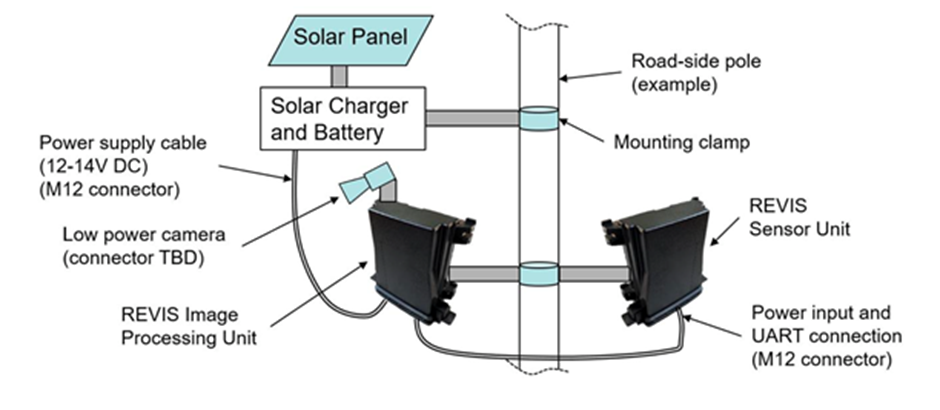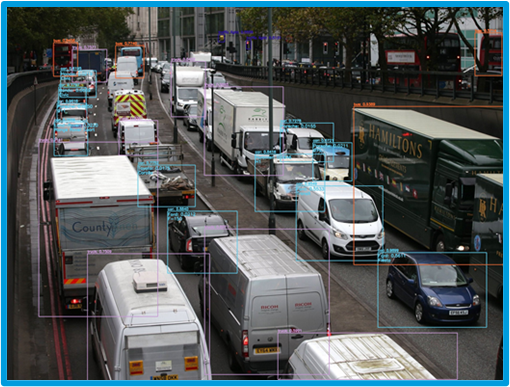Product hardware
During the REVIS project, TerOpta has developed a sensing system which monitors ambient air quality in external environments. Fully cloud-connected via in-built 2G/4G cellular technology, each self-contained unit monitors multiple pollutants and other atmospheric conditions, reporting autonomously to a cloud-based analysis platform. Capable of mounting on poles, posts or walls, the unit is installed by simply connecting a 12V DC power supply. It will then automatically and securely connect to the TerOpta cloud and begin sending data immediately with no user intervention. Extensions to measure ambient noise (SPL) and local road traffic types and volumes are in development
Parameters measured
- Nitrogen Dioxide
- Carbon Dioxide
- Particulate Matter
- Temperature
- Relative Humidity
- Atmospheric Pressure
- Geographic Location
| Measured quantity | Units | Accuracy | Comments |
|---|---|---|---|
| Temperature | °C | ±0.4 | For best accuracy, protect unit from direct sunlight |
| Relative Humidity | % |
±3 start of life ±0.25 /yr drift |
For best accuracy, protect unit from direct sunlight |
| Pressure | hPa | ±1 | |
| PM2.5 and PM10 | µ/m3 | ±10 µ/m3 ±10 % | Over 0 − 100 µ/m3 range Over 100 − 1000 µ/m3 range |
| CO2 | ppm | ±(30ppm +3% of reading) | |
| NO2 | µ/m3 | Approx. ±15 | Preliminary. Note that unit is designed to provide sufficient accuracy to indicate DEFRA Daily Air Quality Index (DAQI) levels for NO2 |
The Teropta hardware unit has been designed to comply with all the following regulations
Radio Equipment Directive (2014/53/EU), IEC 62368-1 Audio/video, information and communication technology equipment ‐ Part 1: Safety requirements, EN61000-6-1 Electromagnetic compatibility (EMC) ‐ Part 6-1: Generic standards ‐ Immunity, EN 61000-6-3 Electromagnetic compatibility (EMC) ‐ Part 6-3: Generic standards ‐ Emissions, RoHS (2011/65/EU) as amended by Directive (EU) 2015/863, WEEE (2012/19/EU).
- 186 x 164 x 64 mm ruggedized enclosure
- Capable of mounting on poles, posts, walls or other surfaces
- Average power consumption <0.3 Watts ‐ can be solar powered
- Waterproof "M12" connector for power and serial communication interface for connection to extension units e.g. traffic type and count
| Pin 1 | RS-232 Serial Transmit |
| Pin 2 | Supply (+11 to +14.5 V DC) |
| Pin 3 | Ground (0V) |
| Pin 4 | RS-232 Serial Receive |
| Pin 5 | Not Connected |

Complimentary Machine Learning Data
Using CCTV data that can be accessed through the customers existing infrastructure, REVIS can undertake machine learning to make predictive analysis based on vehicle flows, regular journeys by the public and vehicle usage patterns.
REVIS Traffic pattern and speed analyser uses a camera and does real-time on-board processing of traffic flow using Artificial Intelligence and object detection models. All data is processed on-device and only the processed traffic patterns are reported in keeping with strict confidentiality and data protection. Hourly Traffic density and average speed will allow councils to determine and demonstrate the impact of traffic density, traffic type and speed limits on NO2 and carbon emissions.

- Support vehicle types: Heavy goods, Light goods, Buses, Vans, Cars, Plant
- Minimum vehicle size: 30x30 pixels
- Accuracy of classifying vehicle type (ie. Car, Van, Bus, Mini, Sedan): greater than 95%
- Max traffic speed: 60 mph
- View angles: front, rear, side view

System Architecture
During our development phase the infrastructure is hosted on an on-site server (located at UWE, Bristol) with plans for the system and AI models to be moved to a secure cloud platform once the project goes live. Sensor data from REVIS will be pushed through Telit (IoT cloud service) and other external public sources such as UK Air department and UK Met Office, where they will be aggregated and stored for trend analysis on the same server.
Data loss and protection against theft are ensured using robust daily backups and secure data encryption/redaction techniques.
